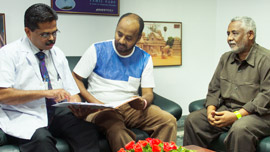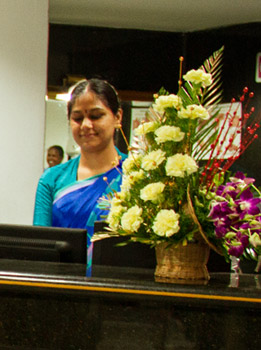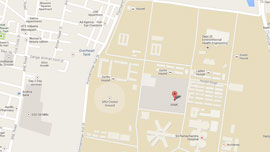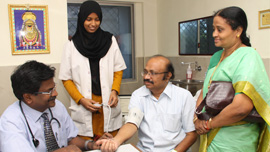Sri Ramachandra Medical Centre
Laparoscopic Surgery
Name of the Surgery : Laparoscopic Surgery
Why is the surgery being performed? Keyhole surgery, or laparoscopic surgery as it is also known, is a method of carrying out an operation without having to make a large incision. Many different types of operations can now be carried out using keyhole surgery. This type of surgery reduces the length of time your child needs to stay in hospital and leaves little scarring.
Anatomical explanation of surgery : Your child will be given a general anaesthesia and will be asleep during the operation. Once your child is asleep, the surgeon inserts a small metal tube called a cannula into your child's tummy button. A telescope, with a miniature video camera mounted on it, is inserted into this tube to project a very high quality video image onto a television screen. The abdomen is then inflated with carbon dioxide to create space in which the surgeon can operate. The operation is performed by inserting specialized instruments, which are passed through small hollow tubes which are inserted through separate very small incisions. There may be two or more small incisions required to perform the operation. Once the operation is over, the surgeon will stitch up the inside of the holes and your child will be taken to the recovery room to wake up from the anaesthesia.
Any special test before surgery : Depending on the procedure, sometimes an ultrasound examination of the abdomen may be done.
Preparations before surgery : Your child should not have anything to eat or drink 6 hours prior to the surgery - otherwise your child's operation may need to be delayed or even cancelled. On the day you come to hospital for the operation, your child's surgeon will explain the operation in detail, discuss any worries you may have and ask you to sign a consent form. An anaesthetist will also see you to explain your child's anaesthetic procedure in more detail. If your child has any medical problems, like allergies, please tell the doctors. Your child may need to have some special preparation for the operation. This may include an enema to empty your child's bowel, so that this does block the surgeon's view of the other internal organs. This is particularly used for children who have special needs.
The risk of surgery : After undergoing the anaesthetic procedure, children sometimes may feel sick and vomit, have a headache, sore throat or feel dizzy. These effects are short-lived. Any surgery carries a small risk of infection or bleeding. After the operation, some older children may complain of shoulder pain. Your child may also feel some crackling under the skin because the carbon dioxide sometimes escapes into the tissue just under the skin. These side effects are usually short-lived and do not require any specialised care. Sometimes the surgeon may not be able to carry out a keyhole surgery on your due to technical reasons or because of unexpected findings. If this is the case, the surgeon will carry out the operation using a larger incision instead.
Care during Hospitalization: After the operation, your child will be taken to the ward for recovery. He or she will always be given some form of pain relief, which can include :
- Epidural which is given through a small space between the bones on the back
- Nurse-controlled analgesia (NCA) which is given through a small plastic needle on the back of the hand.
The amount of pain relief given is controlled either by the nurse or the patient. Your child may also have a nasogastric tube, which is a tube passed through the nose into the stomach, so that he or she can be given feeds or medicines easily. Your child may also have an intravenous (into a vein) infusion of fluids as he or she may not feel like eating and drinking after the operation. You may be able to feel a few lumps under the skin by the wound sites, which are stitches inside the body. This is nothing to worry about and the stitches will dissolve on their own in about three months.
Care at Home :
- Diet: Normal diet
- Bath: Your child should not have a bath or shower for 48 hours after the operation to let the wounds settle down. With some operations there is a small risk of infection, so your child may need to take antibiotics for a while after the operation.
- Care of incision: There will be a small dressing on top of the incision. Do not remove it till you see your doctor on your next visit.
- Activity: Avoid active sports for 2-3 months.
- Medications: Your child may need some pain relief when you get home. Please make sure you have some Paracetamol ready.
- Returning to work: Your child can return to school or nursery when he or she is feeling well. This is usually about one week after the operation.
- Follow-up: The doctor will see you again six weeks after the operation to check that your child is progressing well.
- Call doctor at: 044-24765512 - Ext. - 8182.













